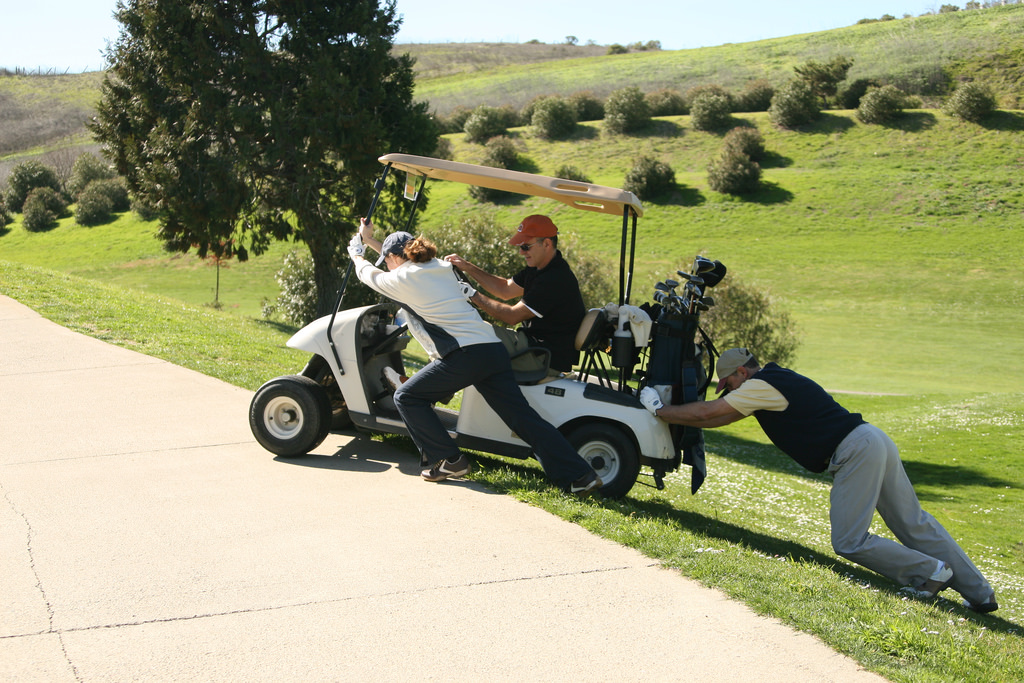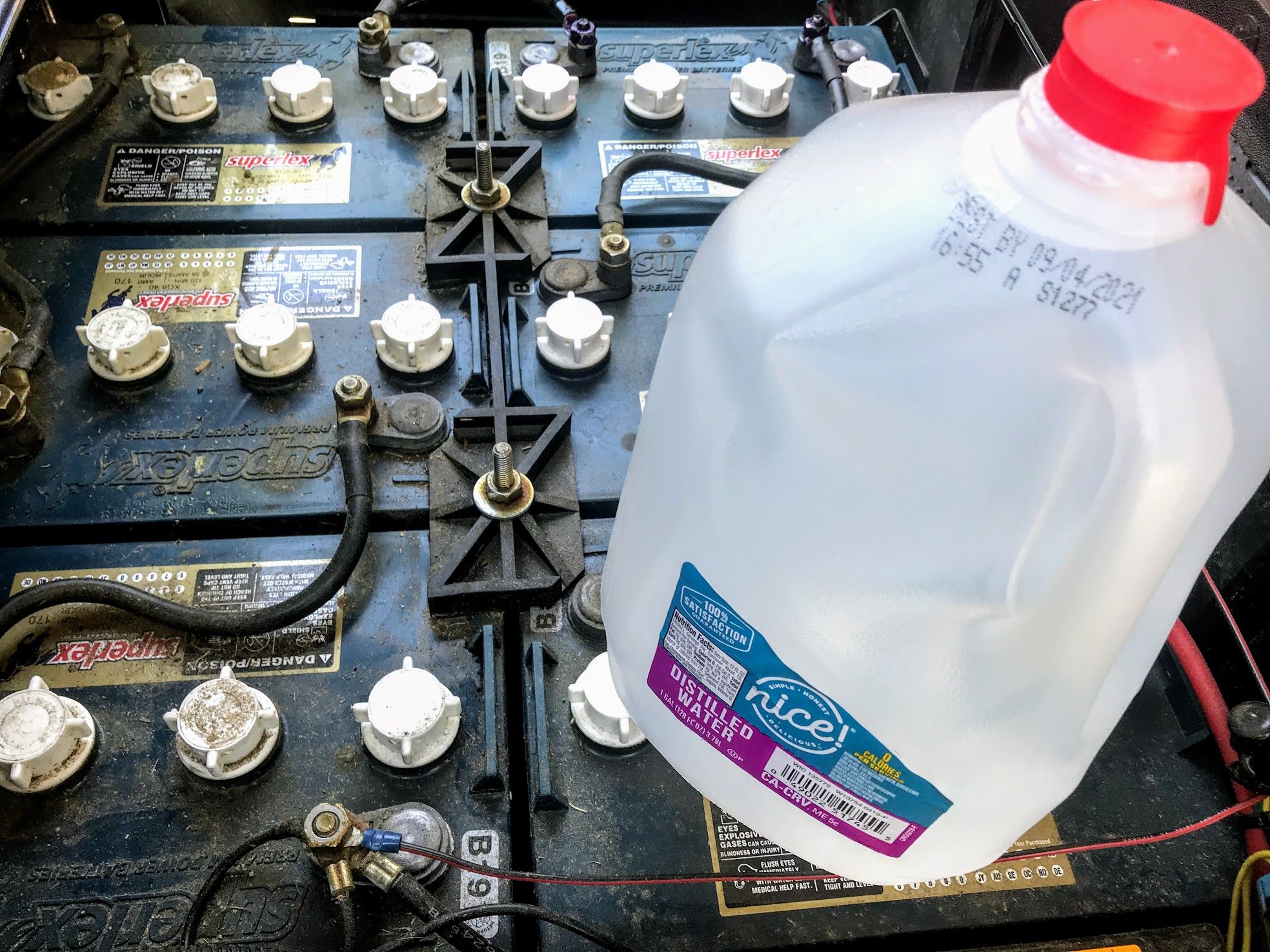
A golf cart is designed to carry two golfers and their equipment around the course with less effort than walking. When you’re electric golf cart struggles on inclines for a variety of reasons, including weak batteries, incorrect tires, or worn-out motor or wiring, you could be in for a long day. You can restore your vehicle’s mobility by calling your local golf car service for help.
When your electric golf cart struggles on inclines, it means that you have to work harder to lift the front wheels. The cart’s batteries interfere with its acceleration, and your speed decreases. Whether your coach is slowing down or not going up hills at all, you are losing valuable time and effort.
If your golf cart doesn’t go up hills, you should check the battery voltage. Hitting all of the green will be difficult if your batteries are weak. A fully charged battery can create up to 24 volts. With a voltmeter, determine how much current you need by checking if your cart will move on flat ground with a dead battery. If your golf cart’s speed drops significantly as it ascends an incline, your batteries may be weak and need replacement. There can be various reasons behind your electric golf cart slowing down up at hills. Let’s find out in this article.
What is an Electric Golf Cart?
Golf carts are electric vehicles using batteries to power an electric motor. These can be charged via wall outlets, or if the golf cart has solar panels fitted to its roof, these can be used. Golf carts are primarily used in sports such as golf or by companies looking to have guests move around a large area or building that is otherwise hard to navigate on foot.
Electric Golf carts have gained popularity in recent years, as inclement weather or physical conditions can make playing golf awkward or downright impossible for some. Operating them is usually straightforward, as the finger controls on each side are intuitive and straightforward to learn about.
The electric golf cart is more straightforward to drive than the gas-powered variety. Just step in, turn the key on, and you are ready to go. The batteries can be renewed by plugging into any standard 110-volt outlet. Golf carts are designed to ease the workload of golf players. This electric golf cart requires batteries to power its electric motor. The battery can be charged in several ways, but the most common method is using a wall plug.
Does an Electric Golf Cart Become Less Potent Over Time?
When your golf cart is struggling with inclines, you need intelligent options. There are many disparate ways to upgrade the battery output of your golf cart to tackle hills easily. An upgraded motor or wiring system can also be installed, and new tires are meant explicitly for mountainous terrain. Here are the reasons listed below:
Tire Size
The more extensive your tires are, the more work your cart needs to do to get uphill. A 140/80-12 tire may not perform as well as a 185/90-12 tire on the same golf cart. Another factor is a load of your coach – a cart that is empty or carrying just one person may roll uphill much better than a fully loaded 4-person golf cart.
Golf Cart Batteries
One of the most common battery-related problems with a golf cart is slow or “dead” batteries. When you’re on the course, it’s essential to have a reliable battery power source. However, corrosion, old age, and other factors can lead to poor battery performance – even if the batteries are relatively new.
Testing Golf cart Batteries
If the cart is going slowly because of bad batteries, your meter should read 0 amps or less, and you will hear a clicking. This is the batteries turning over internally. There will be no problem with the meter reading with good batteries at this point. If there is a zero reading on the meter and no clicking, something besides the batteries is causing your problem. The batteries on the front seat are always the first place to look when a golf cart goes lame.

Brake Solenoid
When your brake solenoid overheats, it will pull all your power through the resistor spring, reducing the energy transmitted to your battery. This is a backyard job and may impact the warranty of your cart and its resale value. So be sure that this is your last resort before proceeding.
Is an Electric Golf Cart Better Than a Gas Cart?
Gas carts are an excellent option for golf courses with long hills, courses where electricity is out of reach for the carts, or when it is too hot to mow. There are also some maintenance benefits to gas carts, and they have come down in price due to technological advances. Expect to pay more than an electric cart but less than a traditional golf cart. You can choose from 4-6 or 8-13hp motors, depending on the weight of your passenger(s). They can be transmitted up to 20 miles per hour, with a slightly slower pace for beginning drivers and safety laps for practice. Gas carts have an average golf course range of 13 to 18 miles per gallon. A battery will last about 10 or 12 holes before it is discharged, then you must recharge it for at least three hours. Depending on your usage, electric carts take from five to eight hours to charge fully.
What Causes a Golf Cart to Lose Power?
Our golf cart batteries provide the optimum value for various golf courses with varying-sized courses and several golfers, from pleasure to championship courses, including municipal, state, and country clubs. We have the right combination of battery designs to meet your specific service needs.
If you don’t use your golf cart often, it’s a good idea to charge and maintain your batteries regularly. If the coach goes without charge for a long time, the battery may lack the minimum voltage required to restart. Batteries also lose their efficiency with age. Golf Carts will run for approximately five years before the battery needs to be replaced or the charger will need replacement.
Concluding, Electric Golf Carts are an environmentally-friendly transportation solution. These golf carts do not use gasoline, so they produce no emissions. In addition, they have less noise than gas carts and cost slightly less to purchase. Electric carts require less maintenance than gas carts, so they offer a low operating cost overall. In addition, some models can also be charged from solar panels or wind turbines. Electric golf carts are friendlier to the environment than gas-powered golf carts. Electric golf carts are much more environmentally responsible than conventional gas-powered ones with no emissions. Electric golf cart motors also produce less sound, making them much more attractive in residential neighborhoods. They are also slightly less expensive on average to purchase.
Motor Performance
The motor in your golf cart plays a critical role in how much power your cart generates. If your cart’s motor is worn out or underperforming, it won’t be able to handle the extra work required to climb hills. Over time, electric motors naturally lose efficiency. The brushes inside the motor can wear down, or the motor itself could overheat after extended use. If your cart struggles going uphill, especially when it used to handle slopes well, it could be time to have the motor inspected or replaced.
One way to prolong the life of your motor is through regular maintenance. Keep the motor clean and free from debris, as overheating can be caused by poor ventilation or dust buildup. If you live in a dusty or sandy environment, such as near the beach or in a desert area, you might need to clean your motor more frequently. Upgrading to a higher-performance motor could also be a solution, especially if you frequently encounter steep inclines on your golf cart’s route.
Controller Issues
The controller is the “brain” of your electric golf cart. It controls the amount of power going to the motor based on how much pressure you put on the accelerator pedal. If your controller is malfunctioning, it could be sending less power to the motor, causing your cart to slow down when going uphill. A faulty controller may not show any obvious signs except for a loss of power when you need it most.
If your controller is overheating or isn’t properly calibrated, it could lead to inconsistent performance, particularly on inclines. In this case, having a technician run diagnostics on the controller can help identify the issue and determine whether it needs adjustment or replacement. For those with an older cart, upgrading to a higher voltage controller may allow for better hill-climbing ability.
Worn-Out Cables and Wiring
In addition to the motor and controller, the wiring that connects your cart’s components can also be a reason for power loss on hills. Over time, the electrical cables that deliver power to the motor may become corroded or frayed. Damaged or worn-out wires can reduce the amount of power reaching the motor, especially under heavy loads, such as when climbing a hill.
A visual inspection of your cart’s wiring can help you spot any loose connections, frayed wires, or signs of corrosion. Regular maintenance and cleaning of the battery terminals and electrical connections will also ensure that your golf cart is delivering power efficiently. If you notice any wear and tear, consider replacing the cables with higher-gauge wires to allow for better conductivity and improved performance on inclines.
Tires and Terrain
The type of tires you use on your golf cart can also affect its ability to go uphill. If your tires are too smooth or worn down, they may struggle to grip the ground, especially on loose or uneven surfaces. Off-road or all-terrain tires typically provide better traction on hilly or grassy areas, making it easier for your cart to ascend steep slopes.
Additionally, if the air pressure in your tires is too low, the increased friction can make it harder for your cart to move uphill. Regularly check your tire pressure and replace worn-out tires to ensure your golf cart has optimal traction. If you frequently drive on hilly terrain, consider upgrading to tires designed specifically for off-road use.
Cart Load and Weight Distribution
An often overlooked factor in power loss when going uphill is the weight your golf cart is carrying. The more passengers or cargo you have, the harder the motor has to work. Overloading your cart beyond its recommended weight capacity can put unnecessary strain on the motor, leading to a loss of power, especially when climbing hills.
Even if your cart isn’t overloaded, how the weight is distributed can also make a difference. If all the weight is towards the back of the cart, the front wheels may lose traction, making it difficult to climb. Try to balance the load evenly and avoid carrying too much weight when heading uphill.
CONTACT US TODAY ABOUT YOUR CART NEEDS

